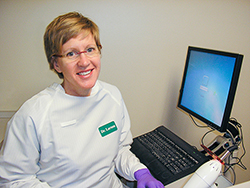A Patient Centered Approach to Care
A Patient-centered Approach to Care

In 2014, when the IHS Hospital staff at Cass Lake, MN, shared the facility’s proposed renovation’s architectural plans with the dental team, a funny thing happened.
The group began to imagine a physical space that looked nothing like most public health dental clinics. They discussed a patient-centered layout using private operatories instead of a provider-accessible design with traditional half-walls and open viewing to patients being treated. The team envisioned a place that would enable confidential conversations about medical histories and dental treatment to take place behind closed doors, while allowing clinicians to keep an eye on patients as they rotated between them.
It was the kind of thinking the Improving Patient Care (IPC) program inspires, explains Dr. Brandy Larson, Cass Lake Hospital’s Dental Chief.
IHS launched the IPC initiative in 2008 and introduced the program to Cass Lake via monthly training sessions and weekly status check-ins led by IHS-trained IPC facilitators. Since its adoption at Cass Lake, the program has touched every aspect of the way Larson and her colleagues do business.
“What IPC really boils down to in my mind is patient- versus provider-centered care,” says Larson. The Cass Lake facility is one of 172 Indian health hospitals and clinics that have adopted the IPC model to improve the delivery of care, boost clinical quality and innovation and ensure patient satisfaction. “Sometimes you intuitively think, ‘I have training. I know what’s best and I’ll use my training to determine what to do here.’ Sometimes it’s easy to forget that often what patients want matters more than what you want for the patients.”
Today, all Cass Lake dental staff now wear identification tags to let their patients know who’s providing their care and to encourage patient feedback. That feedback enables team leaders to recognize clinicians’ good work and inspires others to follow suit.
Monthly team meetings also provide a forum for floating new innovations. Larson’s devotion to IPC’s PDSA method — plan, do, study, act — means that every member of the team can champion an idea to test on a small scale. Larson points out that oftentimes dental assistants see the most promising opportunities for change based on their unique exposure.
For example, one pilot program involved partnering with the hospital’s pediatrics staff by piggybacking on primary care appointments. The dental team also trained pediatric nurses to apply fluoride varnish and give out toothbrushes and toothpaste. These efforts have established a collaborative spirit between the dental and pediatrics staff that continues to evolve.
Scheduling is another critical area touched by IPC. The dental team recognized that patients needed multiple ways to access their dental care, so the clinic switched from “emergency time” to “walk-in time” blocks each morning. This way, patients had access to the dental clinic on a first-come, first-served basis. The dental staff also implemented same-day call-in appointments at the end of each day.
And, lastly, patient empanelment — the practice of consistently assigning the same provider to a patient in order to establish trust and continuity of care — has been instrumental in motivating and teaching patients about preventive care and that good oral hygiene begins at home. Empanelment is critical if you’re looking to reduce tooth decay, extraction procedures and periodontal disease, cites Larson.
Overall, the IPC model has encouraged the facility’s investment in its staff members’ professional development. Dental assistants practice at the highest extent of their licensure and training, doing everything from sealants and fluoride varnishes to simple cleanings and temporary filling placements.
“Our dental assistants have expanded functions for hygiene, and that frees up the dentists to do more advanced procedures. The end result is that we get to see more patients,” Larson explains. “And for our population, which has at least three times the tooth decay rate as the national rate, this is crucial.”


